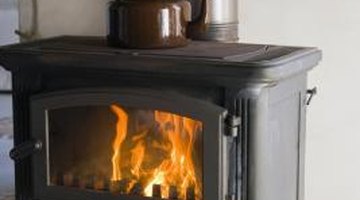Cast Iron Wood Burner Vs. Brick-Lined Steel
Wood burners make use of a renewable resource for generating heat in your home. Wood-burning stoves are built of a variety of materials, including cast iron and brick-lined steel. Determining whether you're better off with a cast iron stove or a brick-lined one will depend on how you intend to use it, the cost you are willing to pay and the lifespan required.
Cast Iron

Cast iron wood burners can be radiant, combustion or circulating stoves. Single-wall cast iron burners heat with radiation -- the heat radiates off the stove wall into the surrounding space. The surface of such a stove gets extremely hot, making it unsuitable for homes with pets or children. Circulating wood burners have double-wall construction, and the heated air between the walls vents out to warm the area. Combustion wood burners burn hotter than other types; you can open the door while the fire is lit, adding oxygen to the flames.
Brick-Lined Steel
Brick-lined steel has a steel exterior and an inner chamber of firebricks. The steel exterior is not as decorative as cast iron, but the bricks inside the steel exterior will let you burn a hotter fire. The brick lining insulates the stove, holding heat inside for radiation through the door or with convection currents. The exterior of a brick-lined wood-burning stove does not get as hot as cast iron because the masonry does not effectively conduct heat to the outside of the burner.
Heat Retention
For the most efficient heating of a space, a brick-lined-steel wood-burning stove is the best option. The bricks lining the inside of the stove absorb heat, and they slowly release that heat. For this reason, you can keep a space warm throughout the day by burning wood in a brick-lined wood-burning stove a few times a day; whereas you'd need to burn wood in a cast iron stove continuously, because heat is lost quickly through radiation.
Lifespan
Cast iron wood-burning stoves have a tough, long-lasting exterior, but the metal can still become damaged. Chips or pitting is most likely to occur on a cast iron stove during shipping or installation. Cast iron stoves last longer than sheet metal wood-burning stoves. Adding a brick lining to steel stoves protects the steel from heat stress and increases the lifespan of the stove. The steel exterior of such wood-burning stoves is extremely durable and, if at least a quarter-inch thick, will last for decades.
Cost
Cast iron stoves come at a premium price. Enhancements such as decorative coatings on the outside or a fan to make it a convection stove will increase the cost. A brick-lined steel wood-burning stove's price will be tied to the thickness of the steel and to other optional features built into the design.
References
- The Whole Building Handbook: How to Design Healthy, Efficient and Sustainable Buildings; Varis Bokalders and Maria Block
- The Homeowner's Guide to Renewable Energy: Achieving Energy Independence Through Solar, Wind, Biomass and Hydropower; Daniel D. Chiras
- Architectural Graphic Standards; Andy Pressman et al.
Photo Credits
- Jupiterimages/Goodshoot/Getty Images
More Articles



